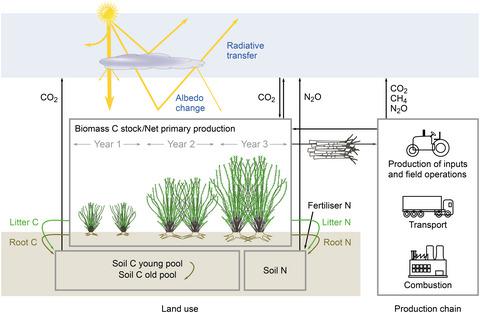当前位置:
X-MOL 学术
›
GCB Bioenergy
›
论文详情
Our official English website, www.x-mol.net, welcomes your
feedback! (Note: you will need to create a separate account there.)
Including albedo in time‐dependent LCA of bioenergy
Global Change Biology Bioenergy ( IF 5.9 ) Pub Date : 2020-04-19 , DOI: 10.1111/gcbb.12682 Petra Sieber 1 , Niclas Ericsson 1 , Torun Hammar 1 , Per‐Anders Hansson 1
Global Change Biology Bioenergy ( IF 5.9 ) Pub Date : 2020-04-19 , DOI: 10.1111/gcbb.12682 Petra Sieber 1 , Niclas Ericsson 1 , Torun Hammar 1 , Per‐Anders Hansson 1
Affiliation

|
Albedo change during feedstock production can substantially alter the life cycle climate impact of bioenergy. Life cycle assessment (LCA) studies have compared the effects of albedo and greenhouse gases (GHGs) based on global warming potential (GWP). However, using GWP leads to unequal weighting of climate forcers that act on different timescales. In this study, albedo was included in the time‐dependent LCA, which accounts for the timing of emissions and their impacts. We employed field‐measured albedo and life cycle emissions data along with time‐dependent models of radiative transfer, biogenic carbon fluxes and nitrous oxide emissions from soil. Climate impacts were expressed as global mean surface temperature change over time (∆T) and as GWP. The bioenergy system analysed was heat and power production from short‐rotation willow grown on former fallow land in Sweden. We found a net cooling effect in terms of ∆T per hectare (−3.8 × 10–11 K in year 100) and GWP100 per MJ fuel (−12.2 g CO2e), as a result of soil carbon sequestration via high inputs of carbon from willow roots and litter. Albedo was higher under willow than fallow, contributing to the cooling effect and accounting for 34% of GWP100, 36% of ∆T in year 50 and 6% of ∆T in year 100. Albedo dominated the short‐term temperature response (10–20 years) but became, in relative terms, less important over time, owing to accumulation of soil carbon under sustained production and the longer perturbation lifetime of GHGs. The timing of impacts was explicit with ∆T, which improves the relevance of LCA results to climate targets. Our method can be used to quantify the first‐order radiative effect of albedo change on the global climate and relate it to the climate impact of GHG emissions in LCA of bioenergy, alternative energy sources or land uses.
中文翻译:

将反照率包括在生物能源的时间依赖性LCA中
原料生产过程中的反照率变化会大大改变生物能源的生命周期对气候的影响。生命周期评估(LCA)研究已经根据全球变暖潜势(GWP)比较了反照率和温室气体(GHG)的影响。但是,使用全球升温潜能值会导致在不同时间尺度上起作用的气候力量比重不均等。在这项研究中,反照率被包括在时间依赖的LCA中,它解释了排放的时间及其影响。我们采用了实地测得的反照率和生命周期排放数据,以及随时间变化的辐射传输,生物碳通量和土壤一氧化二氮排放模型。气候影响表示为全球平均地表温度随时间的变化(ΔT)和GWP。分析的生物能源系统是在瑞典原休耕地上生长的短旋柳产生的热量和电力。我们发现,由于高输入量的土壤固碳,每公顷ΔT( 100年为−3.8×10 –11 K)和每MJ燃料的GWP 100(−12.2 g CO 2 e)产生的净冷却效应。柳根和凋落物中的碳。反照率是更高下柳树比休耕,有助于冷却效果和占GWP的34%100,Δ36%Ť在每年50和Δ的6%Ť在第100年。反照率在短期温度响应(10-20年)中占主导地位,但相对而言,随着时间的推移,重要性不再那么重要,这是由于持续生产下土壤碳的积累和温室气体的扰动寿命更长。ΔT明确了影响的时机,这改善了LCA结果与气候目标的相关性。我们的方法可用于量化反照率变化对全球气候的一阶辐射效应,并将其与生物能源,替代能源或土地利用的生命周期评估中温室气体排放的气候影响联系起来。
更新日期:2020-04-19
中文翻译:

将反照率包括在生物能源的时间依赖性LCA中
原料生产过程中的反照率变化会大大改变生物能源的生命周期对气候的影响。生命周期评估(LCA)研究已经根据全球变暖潜势(GWP)比较了反照率和温室气体(GHG)的影响。但是,使用全球升温潜能值会导致在不同时间尺度上起作用的气候力量比重不均等。在这项研究中,反照率被包括在时间依赖的LCA中,它解释了排放的时间及其影响。我们采用了实地测得的反照率和生命周期排放数据,以及随时间变化的辐射传输,生物碳通量和土壤一氧化二氮排放模型。气候影响表示为全球平均地表温度随时间的变化(ΔT)和GWP。分析的生物能源系统是在瑞典原休耕地上生长的短旋柳产生的热量和电力。我们发现,由于高输入量的土壤固碳,每公顷ΔT( 100年为−3.8×10 –11 K)和每MJ燃料的GWP 100(−12.2 g CO 2 e)产生的净冷却效应。柳根和凋落物中的碳。反照率是更高下柳树比休耕,有助于冷却效果和占GWP的34%100,Δ36%Ť在每年50和Δ的6%Ť在第100年。反照率在短期温度响应(10-20年)中占主导地位,但相对而言,随着时间的推移,重要性不再那么重要,这是由于持续生产下土壤碳的积累和温室气体的扰动寿命更长。ΔT明确了影响的时机,这改善了LCA结果与气候目标的相关性。我们的方法可用于量化反照率变化对全球气候的一阶辐射效应,并将其与生物能源,替代能源或土地利用的生命周期评估中温室气体排放的气候影响联系起来。











































 京公网安备 11010802027423号
京公网安备 11010802027423号